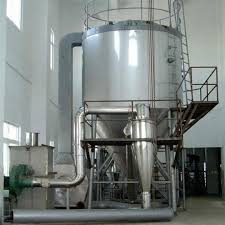Introduction to Spray Drying Technology
A spray dryer is an industrial machine widely used to convert liquid solutions, suspensions, or slurries into dry powder form through a hot gas drying process. This method is preferred for its rapid drying time, which can range from a few seconds to several minutes, and its ability to produce uniform particle sizes with relatively low moisture content.
Key Components and Operation
The core of a spray dryer includes three main components: the feed pump, the atomizer, and the drying chamber. The feed pump moves the liquid into the dryer. The atomizer, a crucial part, transforms the liquid into a fine mist. Choices for atomizers can be either rotary (wheel) or nozzle, with each type offering specific advantages depending on the application. For instance, rotary atomizers can handle a wider range of liquid properties and are less likely to clog, making them ideal for solutions with solid particles.
The drying chamber is where the magic happens. Here, the sprayed liquid interacts with hot air (or another gas) at temperatures generally between 160°C to 240°C. This interaction causes rapid evaporation of the water content, leaving behind dry particles that are then collected at the bottom of the chamber.

Applications Across Industries
Spray drying plays a pivotal role in many sectors. In the food industry, it is essential for producing milk powder, coffee, tea, spices, and flavorings. This method ensures flavor retention, consistent powder quality, and longer shelf life. In the pharmaceutical field, spray drying is utilized to create consistent, bioavailable pharmaceutical compounds. The technology also finds applications in the ceramic industry and in the creation of fine chemicals.
Advantages of Using a Spray Dryer
The choice to use a spray dryer comes with multiple benefits. Primarily, it allows for the control of particle size, shape, and moisture content, which are critical parameters in the quality and functionality of the final product. It's also scalable from small laboratory setups to large-scale manufacturing processes, demonstrating its versatility across various batch sizes.
Efficiency is another significant advantage. Spray dryers can process a large volume of liquid quickly and convert it into a dry form more efficiently than many other drying methods. This efficiency can often justify the initial higher cost of setup in terms of reduced processing time and energy usage.
Maintenance and Operational Considerations
Maintaining a spray dryer is crucial for its operational efficiency and longevity. Key maintenance tasks include regular cleaning to prevent clogging and buildup, routine checks on the atomizer and feed pump, and temperature adjustments based on the feed material. Operational costs, mainly driven by energy use, can be significant, but proper maintenance and optimized operation strategies can mitigate these expenses.
Explore More about Spray Dryers
For more detailed insights on spray dryers, their applications, and how they can transform your production process, visit this comprehensive resource on spray dryers.
Conclusion
In essence, spray dryers are invaluable tools in modern manufacturing, suited for a vast array of industries. They offer a fast, reliable method to produce high-quality dry powders, enhancing product stability and easing subsequent handling and storage. The technology behind spray drying continues to evolve, driven by advances in materials science and process engineering, promising even greater efficiencies and applications in the future.